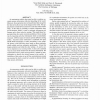129 search results - page 11 / 26 » Sensor Selection Using Information Complexity for Multi-sens... |
IROS
2008
IEEE
2008
IEEE
HybridExploration: A distributed approach to terrain exploration using mobile and fixed sensor nodes
14 years 2 months ago
— When an emergency occurs within a building, it may be initially safer to send autonomous mobile nodes, instead of human responders, to explore the area and identify hazards and...
MVA
1990
13 years 8 months ago
1990
An autonomous mobile robot must be able to combine uncertain sensory information with prior knowledge of the world. Moreover, these operations have to be performed fast enough for...
ASC
2004
13 years 7 months ago
2004
In this paper, we describe development of a mobile robot which does unsupervised learning for recognizing an environment from action sequences. We call this novel recognition appr...
RAS
2006
13 years 7 months ago
2006
In this paper we examine issues of localization, exploration, and planning in the context of a hybrid robot/camera-network system. We exploit the ubiquity of camera networks to us...
IDA
2003
Springer
14 years 24 days ago
2003
Springer
For a mobile robot to act autonomously, it must be able to construct a model of its interaction with the environment. Oates et al. developed an unsupervised learning method that pr...

